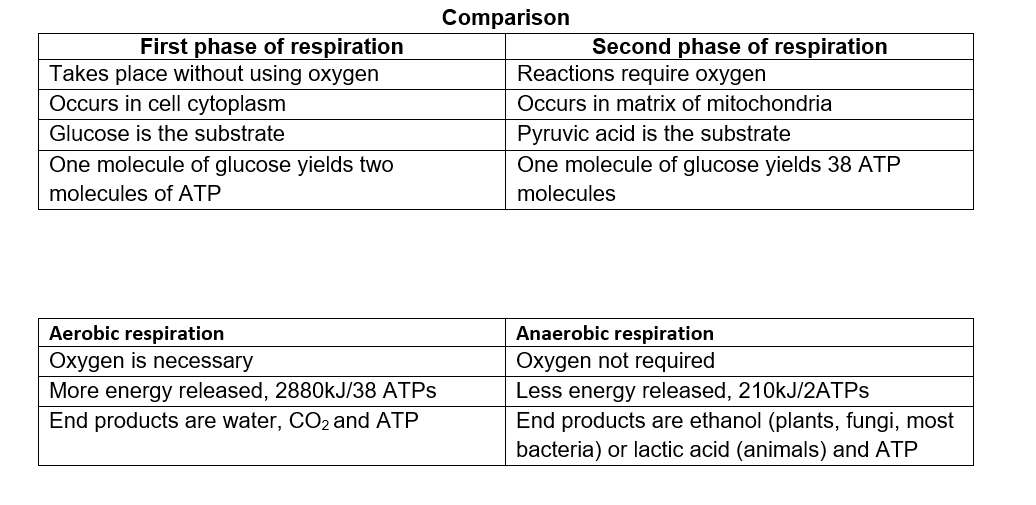Definition: process by which food substances are chemically broken down in all living cells to release energy, carbon (IV) oxide and water or alcohol
- Tissue respiration takes place in mitochondria. These organelles occur in large numbers in cells of organs that require a lot of energy e.g. kidney cells, muscle cells, sperm cells
- Adaptations: mitochondria have folded inner membrane forming cristae to provide a large S/A for respiratory activities; have a fluid filled cavity called matrix in which respiratory reactions take place; have their own genetic material DNA that enables them to self replicate independently of the cell
The Process of Respiration
- If the energy produced during respiration were to be released at once, the heat would burn the body cells (some energy is always released as heat)
- To prevent this, energy is released in small quantities and in stages
- During respiration, energy produced is used to cause reaction between adenosine diphosphate (ADP) and an inorganic phosphate molecule, to form another compound called adenosine triphosphate (ATP)
ADP + PO43- + Energy = ATP
- The overall equation for respiration:
C6H12O6 + 6O2 respiratory enzymes 6CO2 + 6H2O + energy (ATP)
- ATP molecules store energy released in respiration
- ATP readily breaks down into ADP and phosphate, releasing energy locked in its bonds
- The first phase of respiration takes place without using oxygen
- It involves the breakdown of glucose to pyruvic acid
- it takes place in the cytoplasm of cells
- glucose is broken down (glycolysis) into a three carbon compound called pyruvic acid
- Glycolysis produces two molecules of ATP per molecule of glucose.
- The fate of pyruvic acid depends on whether oxygen is available or not
- Normally pyruvic acid proceeds onto the second phase of respiration in which it is completely oxidised into carbon (IV) oxide, water and energy (ATP).
- Oxygen is needed in the second phase
- It takes place in the matrix of mitochondria
- It produces 38 molecules of ATP per molecule of glucose.
- If there is no oxygen, pyruvic acid is converted to lactic acid (in animals) or ethanol (in plants, fungi, and in most bacteria)
- Lactic acid stores a lot of energy, and when oxygen is available, it is converted back to pyruvic acid, which is then used in the aerobic phase of respiration
- The process of anaerobic respiration is summarised as:
- In plants: C6H12O6 2C2H5OH + CO2 + Energy
- In animals: C6H12O6 2C3H6O3 + Energy
Q Write a simple equation to show how ATP is synthesised from ADP[1]
Q Give two ways in which the properties of ATP make it a suitable source of energy in biological processes [2]
Oxygen Debt
- It is the oxygen required to get rid of lactic acid that accumulates in the body when the supply of oxygen is less than the demand e.g. during a race
- Lactic acid is toxic, and causes fatigue and muscle cramps. However, it also locks up a lot of energy in its bonds, which should be availed to the body.
- Oxygen debt is paid back after the race when the person breaths in quickly and more deeply so as to increase the supply of oxygen
- During the process of paying back the oxygen debt, lactic acid is converted to pyruvic acid, which is then oxidised to carbon (IV) oxide, water and energy.
- Lactic acid can also be taken to the liver and converted into glycogen for storage
Application of Anaerobic Respiration
- Production of ethanol, wine, cider, beer and spirits by fermentation of sugars
- Biogas production
- Making of compost manure
- Production of vinegar, citric acid, oxalic acid and some drugs

Respiratory Quotient (RQ) And its Significance
- RQ is a ratio of the amount of CO2 produced against the amount of O2 consumed during respiration i.e.
RQ = volume of CO2 produced / Volume of O2 consumed
- RQ for carbohydrates = 1.0; fats/lipids = about 0.7; proteins = about 0.9
- Significance of RQ values
- Indicates type of substrate
- Indicates conditions under which substrates are respired, whether aerobic, anaerobic or both
- RQ depends on age, state of health and temperature
Factors Affecting Rate of Respiration
- Oxygen concentration
- Substrate concentration
- Hormones: adrenaline and thyroxine increase respiration rate
- Body size/SA:V ratio
Practice Questions
- Some sterile seeds were soaked in water for 4 hours before being left in moist air to germinate. The respiratory quotient (RQ) values of these seeds are shown in the table below.

Account for the changes in RQ values of the germinating seeds:
- Immediately after soaking [3]
- After 12 hours in air [2]
- After 36 hours in air [3]
Q Desert iguanas are lizards that live in hot, dry conditions. Scientists measured the rate of oxygen consumption of desert iguanas at different body temperatures. Some of their results are shown in the table.

Explain how an increase in the iguana’s body temperature affects its oxygen consumption when it is at rest.
Q Name the organism that causes tuberculosis (TB).
Explain how TB is transmitted from an infected person to an uninfected person.
Q Explain why carbohydrates release half as much energy per unit mass as fats and oils.[2]